|
|
| Line 101: |
Line 101: |
| | </tr> | | </tr> |
| | </table> <!-- END Driver Command Bar --> | | </table> <!-- END Driver Command Bar --> |
| | + | <table width=1000> <!-- BEGIN Instruction Set--> |
| | + | <tr valign="top"> |
| | + | <td colspan=3> |
| | <br> | | <br> |
| | ----- | | ----- |
| − | <table width=1000> <!-- BEGIN Instruction Set--> | + | <br> |
| | + | </tr> |
| | <tr valign="top"> | | <tr valign="top"> |
| | <td colspan=3 bgcolor="lightcyan"> | | <td colspan=3 bgcolor="lightcyan"> |
| Line 109: |
Line 113: |
| | <tr valign="top"> | | <tr valign="top"> |
| | <td>[[file:DotPoint.JPG|link=]]</td> | | <td>[[file:DotPoint.JPG|link=]]</td> |
| − | <td><span style="font-weight: 700;">If you don't want to use EITs then skip steps <span style="color: white; background-color: blue; font-size: 16px;"> 1 </span>, <span style="color: white; background-color: blue; font-size: 16px;"> 3 </span> and <span style="color: white; background-color: blue; font-size: 16px;"> 5 </span></span></td> | + | <td><span style="font-weight: 700;">If you don't want to use EITs then go straight to Step <span style="color: white; background-color: blue; font-size: 16px;"> 2 </span></span></td> |
| | </tr> | | </tr> |
| | </table> <!-- END Dot Point --> | | </table> <!-- END Dot Point --> |
| Line 177: |
Line 181: |
| | <tr valign="top"> | | <tr valign="top"> |
| | <td colspan=3> </td> | | <td colspan=3> </td> |
| | + | </tr> |
| | + | <tr valign="top"> |
| | + | <td colspan=3> |
| | + | <br> |
| | + | ----- |
| | + | <br> |
| | </tr> | | </tr> |
| | <tr valign="top"> | | <tr valign="top"> |
| Line 252: |
Line 262: |
| | </tr> | | </tr> |
| | <tr valign="top"> | | <tr valign="top"> |
| − | <td colspan=3 bgcolor="lightcyan"> </td> | + | <td colspan=3> |
| | + | <br> |
| | + | ----- |
| | + | <br> |
| | </tr> | | </tr> |
| | + | <td colspan=3 bgcolor="lightcyan"> |
| | + | <table cellpadding="4"> <!-- BEGIN Dot Point --> |
| | + | <tr valign="top"> |
| | + | <td>[[file:DotPoint.JPG|link=]]</td> |
| | + | <td><span style="font-weight: 700;">If you don't want to use EITs then go straight to Step <span style="color: white; background-color: blue; font-size: 16px;"> 4 </span></span></td> |
| | + | </tr> |
| | + | </table> <!-- END Dot Point --> |
| | + | </td> |
| | <tr valign="top"> | | <tr valign="top"> |
| | <td align="center" bgcolor="lightcyan">'''Step'''<br>[[image:DotPoint3Blue.JPG|link=]]</td> <!-- Instruction 3 --> | | <td align="center" bgcolor="lightcyan">'''Step'''<br>[[image:DotPoint3Blue.JPG|link=]]</td> <!-- Instruction 3 --> |
| Line 309: |
Line 330: |
| | <td colspan=3> </td> | | <td colspan=3> </td> |
| | </tr> | | </tr> |
| − | | + | <tr valign="top"> |
| | + | <td colspan=3> |
| | + | <br> |
| | + | ----- |
| | + | <br> |
| | + | </tr> |
| | <tr valign="top"> | | <tr valign="top"> |
| | <td colspan=3 bgcolor="lightcyan"> </td> | | <td colspan=3 bgcolor="lightcyan"> </td> |
| Line 341: |
Line 367: |
| | <td colspan=3> </td> | | <td colspan=3> </td> |
| | </tr> | | </tr> |
| − |
| |
| | <tr valign="top"> | | <tr valign="top"> |
| − | <td colspan=3 bgcolor="lightcyan"> </td> | + | <td colspan=3> |
| | + | <br> |
| | + | ----- |
| | + | <br> |
| | </tr> | | </tr> |
| | + | <td colspan=3 bgcolor="lightcyan"> |
| | + | <table cellpadding="4"> <!-- BEGIN Dot Point --> |
| | + | <tr valign="top"> |
| | + | <td>[[file:DotPoint.JPG|link=]]</td> |
| | + | <td><span style="font-weight: 700;">If you don't want to use EITs then go straight to Step <span style="color: white; background-color: blue; font-size: 16px;"> 6 </span></span></td> |
| | + | </tr> |
| | + | </table> <!-- END Dot Point --> |
| | + | </td> |
| | <tr valign="top"> | | <tr valign="top"> |
| | <td align="center" bgcolor="lightcyan">'''Step'''<br>[[image:DotPoint5Blue.JPG|link=]]</td> <!-- Instruction 5 --> | | <td align="center" bgcolor="lightcyan">'''Step'''<br>[[image:DotPoint5Blue.JPG|link=]]</td> <!-- Instruction 5 --> |
| Line 357: |
Line 393: |
| | <tr valign="top"> | | <tr valign="top"> |
| | <td colspan=3> </td> | | <td colspan=3> </td> |
| | + | </tr> |
| | + | <tr valign="top"> |
| | + | <td colspan=3> |
| | + | <br> |
| | + | ----- |
| | + | <br> |
| | </tr> | | </tr> |
| | <tr valign="top"> | | <tr valign="top"> |
|
|
 |
If you don't want to use EITs then go straight to Step 2 |
|
Step
 |
Setting an EIT Path from a Starting Signal
The first path to be set in this tutorial is from the Gladstone Goods Loop to Broken Hill . On the Gladstone  page (link via page (link via  - link will open in this window) this is identified on that page as:- - link will open in this window) this is identified on that page as:-

From the open Driver Command Menu, select the IT SetPath (TANE SP4 and later) option. This will open a list of all the EITs that have been placed in the Session. Because an EIT Starting Signal, in this case invisible signal GSX G27D, is directly in front of the loco, the signal will be included in the EIT list.
 |
Select the starting signal GSX G27D . This will reveal that two different paths out of Gladstone start from this signal.
- Goods Loop to Broken Hill , and
- Goods Loop to Wilmington
|
Select the path Goods Loop to Broken Hill .
 |
Selecting a path to or from an outside location will NOT set the entire path to/from that location (e.g. all the way to Broken Hill). It will only set the path between the Starting Signal and the Exit Signal. Either both signals will be just outside the yard or one will be within the yard and the other just outside |
Every path is named according to its starting point (one of five locations or a track in the local yard) and its destination (one of five locations or a track in the local yard). The five locations are Port Pirie, Broken Hill, Terowie, Quorn and Wilmington even if that location is not the destination or starting point of the consist. This is intended to indicate the direction of travel only.
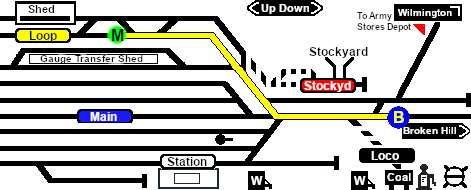 |
The path has now been set.
All junction switches and signals along that path from the Start Signal (GSX G27D) to the Exit Signal (Gladstone Home Up) are set to give loco T 258 the road out of Gladstone towards Broken Hill.
Note: not all signals will automatically show Proceed once the path has been set. Some signals, semaphore signals for example, will only show Proceed when a train starts moving towards the signal. |
Cancelling a Set EIT Path
Paths that have been set can be cancelled so that their signals and junction switches will be returned to their previous states. They will be returned automatically after the consist has cleared the Exit Signal for a path but if you change your mind and decide to take a different path or not use the EITs then a set path can be cancelled.
From the Driver Command Menu select the IT CancelEnhancedPath command.

You will have the option of cancelling ALL PATHS or selecting a particular EIT and path to cancel.
|
|
| |
| |
|
|
| |
Step
 |
Driving to the Next EIT Location
 |
There is a minor location, Yangya, between Gladstone and Caltowie but it has no EIT, minimal yard infrastructure, no signals and its switches are set for the main line through to Caltowie |
You have two options for driving to Caltowie, the next EIT location. Manual and AI control.
 Manual Control Manual Control
You can manually drive the train through to Caltowie without using the EIT (as described in Step 1 above). This would require that all the switches along the path be correctly set first. You can do this by manually setting all the switches yourself using the information on the Gladstone  page (link via page (link via  - link will open in this window). - link will open in this window).
|

 |
Part of this page is shown left with only those switches relevant to this tutorial scenario. The red dots indicate the yard Start and Exit positions for the train path.
Also shown left below is the Switch Set data, taken from the same page, for the path Gladstone Goods Loop to Broken Hill . The switch directions, L or R are the directions when facing the junction fork i.e. the L and R that determine which direction a train will take when passing over the junction.
Switch 20 does not need to be set as the consist is beyond the switch. |
You can now use the Driver Control Dial or the keyboard controls to drive the train out of Gladstone Yard to Caltowie. Alternatively, for those with advanced steam loco driving skills, you can take control of the throttle, brake and other various devices in the loco cab.
 AI Control AI Control
You can also drive by adding Driver Commands directly into the Driver Command Bar on the bottom right of the screen. The Drive To, Drive to Trackmark, Drive via commands that will automatically set all the path switches are available in all scenarios for your use. A large number of Track Marks and some industies have been added to provide destinations for these commands.
The approach to every location in the route has  Track Marks added to allow you to use this method to let the AI do most of the driving work. These track marks are placed a short distance ahead of the approach home signal, a semaphore signal, at those locations that have visible signals. Where the location has no visible signals (the majority of locations in the division were unsignalled) then a visible Caution track sign has been placed alongside the track mark. Track Marks added to allow you to use this method to let the AI do most of the driving work. These track marks are placed a short distance ahead of the approach home signal, a semaphore signal, at those locations that have visible signals. Where the location has no visible signals (the majority of locations in the division were unsignalled) then a visible Caution track sign has been placed alongside the track mark.
The Track Marks are shown on the Caltowie  page (link via page (link via  - link will open in this window). - link will open in this window).
|
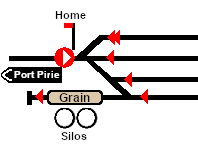
|
Part of this page is shown left. The approach track mark on the Port Pirie side is Caltowie Main Approach Dn. This is also identified in the data table, also copied from the same page, shown below.

From the Driver Command Menu select the command Drive To Trackmark then find and select the track mark Caltowie Main Approach Dn .
|
 |
Using the Drive commands in yards with many switches, such as Gladstone, will work but the consist will display a "stop-start" motion as it slowly navigates its way through the switches. If you use the EIT to set the path first then use the Drive commands, the consist will move without any delays. |
|
|
| |
| |
|
|
 |
If you don't want to use EITs then go straight to Step 4 |
|
Step
 |
Setting the Next EIT
You can set an EIT path without having to be directly in front of a Starting Signal. For example, you can set all the EIT paths for the train through Caltowie and into Jamestown before you even leave Gladstone.
To set a path for a distant EIT, from the open Driver Command Menu, select the IT SetPath (TANE SP4 and later) option. Then select the EIT from the list.
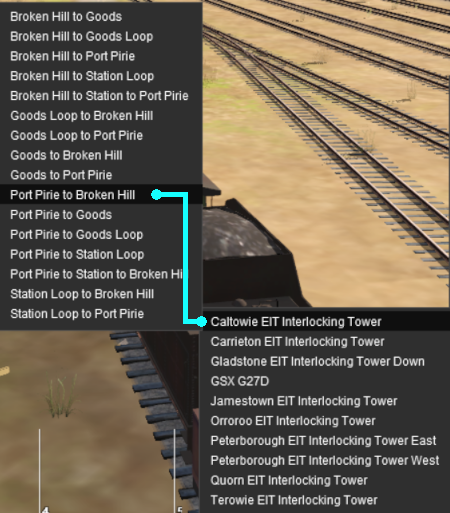 |
Select the Caltowie EIT Interlocking Tower . This will open a list of ALL the EIT paths controlled by the Caltowie EIT, including any paths that will not be directly accessable to your consist.
Select the path Port Pirie to Broken Hill . On the Caltowie  page (link via page (link via  - link will open in this window) this is identified as:- - link will open in this window) this is identified as:-

This will set a direct path, via the Main Line, through Caltowie Yard towards Broken Hill.

You could also select any of the Port Pirie to ... paths. The only other through path is Port Pirie to Station to Broken Hill which will take you through the yard via the Station. The other Port Pirie to ... paths will take you into the yard but will not provide a set path out. You will need to select and set one of the ... to Broken Hill paths to exit the yard.
|
If you have manually driven to the Caltowie Home Dn signal (or used the AI Drive To Trackmark Caltowie Main Approach Dn command) then open the Driver Command Menu. The name of the Start Signal Caltowie Home Dn will appear in the EIT list.
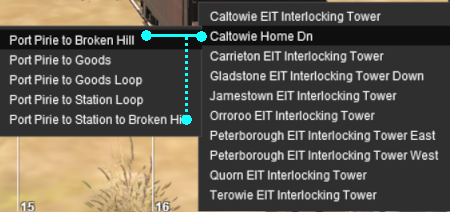 |
Select Caltowie Home Dn . This will open a list of all its assigned paths.
Select the through path you want, for example Port Pirie to Broken Hill or Port Pirie to Station to Broken Hill .

Path via Caltowie Station
|
|
|
| |
| |
|
|
| |
Step
 |
Driving Through Caltowie
 Manual Control Manual Control
To manually drive the train through to Caltowie without using the EIT you will have to manually set all the switches along the path yourself using the information on the Caltowie  page (link via page (link via  - link will open in this window). - link will open in this window).
 |
Because Caltowie is a fairly simple yard, the switch sets are not complex.
- Port Pirie to Broken Hill via Main - 1 - R 2 - L 6 - R 7 - L
- Port Pirie to Broken Hill via Station - 1 - L 7 - R
|
|
|
| |
| |
|
|
 |
If you don't want to use EITs then go straight to Step 6 |
|
Step
 |
Setting the Jamestown EIT
|
|
| |
| |
|
|
| |
Step
 |
Driving into Jamestown
|
|
| |
| |
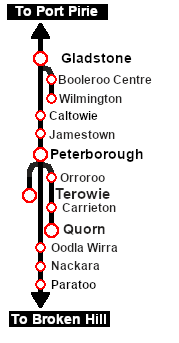
![]() Gladstone-Peterborough Depot Fuel which has the consist already fully assembled with its locomotive (T 258) at the starting signal of the Gladstone EIT Goods Loop to Broken Hill path. This tutorial will follow the scenario until after the consist arrives at Jamestown.
Gladstone-Peterborough Depot Fuel which has the consist already fully assembled with its locomotive (T 258) at the starting signal of the Gladstone EIT Goods Loop to Broken Hill path. This tutorial will follow the scenario until after the consist arrives at Jamestown.










